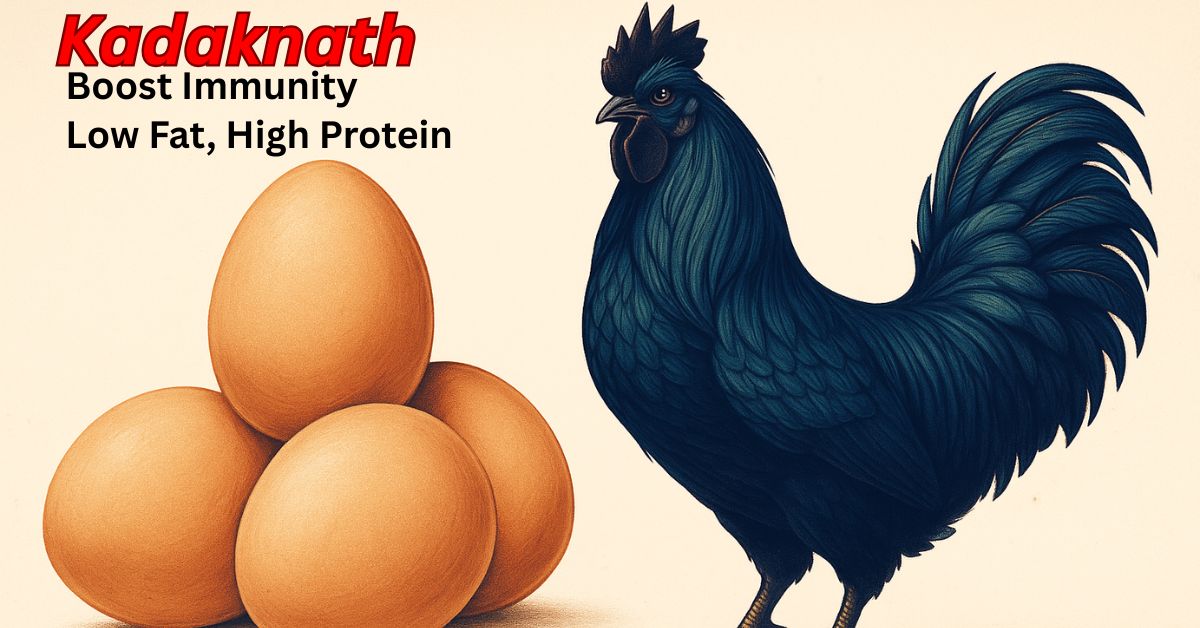When you think of chicken, you probably picture a regular white or brown bird. But have you ever come across a chicken that’s black — not just its feathers, but also its skin, flesh, and even its bones? Meet the Kadaknath, a rare and fascinating breed from India that’s become a sensation for more reasons than one.
A Bird with Deep Roots
Kadaknath, also known locally as Kali Masi, which means “black meat,” is a native breed that originated in the tribal belt of Jhabua and Dhar in Madhya Pradesh. It has long been raised by local Bhil and Bhilala tribes, who not only valued it for food but also held it as a part of their traditions and culture. In fact, for many years, the bird was mostly found roaming in the forests of Kathiwada, Alirajpur, and Para Jhabua, until its unique features started catching attention across the country.
In 2018, Kadaknath meat earned a Geographical Indication (GI) tag, officially recognising it as a product of a specific region with distinct characteristics — something that helped boost its popularity even more.
What Makes Kadaknath So Special?
The most noticeable feature of the Kadaknath is its striking black colour. From feathers to skin, beak to internal organs, even the blood carries a dark hue, all thanks to a condition called fibromelanosis — an unusual pigmentation caused by high melanin levels. This gives the bird its signature look and a mysterious, exotic appeal.
There are three known varieties of Kadaknath based on plumage: jet black, golden, and pencilled. While all have the characteristic black meat, each has slight visual differences.
A Superfood in Feathered Form
Kadaknath meat is gaining traction not just for its looks, but also for its nutritional punch. It’s packed with high protein, low fat, and rich iron content, making it a healthier option compared to regular broiler chicken. The abdominal fat in Kadaknath meat ranges from just 0.11 to 0.52%, while broiler chicken can go up to 1.85%.
Many believe the meat helps in building strength and stamina, which is also reflected in its name — “Kadak” means strong in Hindi. Traditional communities have long consumed it for its medicinal value, and with today’s health-conscious consumers turning towards organic and nutrient-rich food, Kadaknath is in high demand.
Even the eggs of Kadaknath are unique. Though the hens lay fewer eggs — around 120 to 140 per year — they are light brown with a slight pinkish tint, and offer a healthier alternative to regular chicken eggs.
Thriving in Tough Conditions
One of the reasons why this breed is ideal for rural India is its resilience. Kadaknath chickens can tolerate extreme weather, from scorching heat to biting cold, and thrive even under minimal care. They’re naturally more resistant to diseases compared to other breeds, making them perfect for small-scale or backyard farming.
That said, they do come with a few challenges. Kadaknath birds grow slower, reach sexual maturity later, and produce fewer eggs than commercial breeds. But what they lack in speed, they make up for in market value.
A Booming Market Opportunity
With increasing awareness of healthy meat and traditional food, the Kadaknath market is seeing a sharp rise in demand. Prices for its meat range between Rs. 800 to Rs. 1000 per kg, and eggs can fetch Rs. 20 to Rs. 35 each, making it a profitable venture for rural farmers.
Take the example of Veer Singh, a farmer who sold his batch of birds to a trader from Gujarat for Rs. 27,000. After expenses, nearly 70% was pure profit. Or Pushpa Dhohare from Jhabua, who started with 500 birds and now manages over 2,000 chickens along with a hatchery that houses up to 10,000.
The Future of Kadaknath Farming
As consumers look for sustainable, healthier food options, Kadaknath has a bright future in both rural and urban India. The bird’s uniqueness, along with its adaptability, makes it a prime candidate for organic and free-range poultry farming. With proper training and awareness, many more small farmers can turn Kadaknath into a steady source of income.
In a world that’s increasingly going back to its roots for answers on health, tradition, and sustainability, the Kadaknath chicken stands out — not just as a bird, but as a symbol of India’s rich agricultural heritage and natural diversity.
